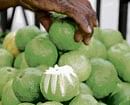

It’s the season for guavas and apart from relishing this lovely tropical fruit with a dash of chilli powder and salt, there are other ways you can make the most of it while the fruit is still in season. My favourites are a guava drink and guava cheese, a chewy, fudge-like sweet that acquires a reddish tinge when done. Both are absolutely delicious, but while the drink can be made in no time, the sweet entails some painstaking work.
The fruit itself is a storehouse of vitamin C, and the leaf of the guava tree has its uses in tribal and herbal medicine. In some countries the leaves are used in barbeques to impart a smoky flavour to the meat.
Forbidden fruit
Back in the ’70s, the guava seller was a permanent fixture by our school gate, with the fruit arranged on a bed of fresh green leaves in a wide basket hitched to the back of his bicycle. Heedless of warnings against eating “roadside stuff”, we would scramble past the gates after lunch to buy it. Needless to say, like all forbidden fruit, it always tasted better. The “guava man” would lop off the pip and deftly slash it in fours with a slim, sharp knife, keeping the base intact before sliding some of the spicy-salty mix through the centre. Pretty much the same scene exists at prominent street corners and outside certain school gates even today.
Back then, Koramangala was a green expanse, with isolated houses, and a number of guava orchards. A far cry from the concrete sprawl it is today. The only landmarks I can recall are Mico, John Fowler and of course, St. John’s Medical College and Hospital. My classmate lived there and the two of us had once trespassed into an orchard to pluck a few only to be shooed away by a caretaker who, without doubt, did his job very well! The guava tree also grew commonly in compounds of old bungalows.
Dorm delight
My earliest recollection of tucking into guava cheese was when we lived in Goa, where it’s called perada. Years later, while studying in a Madras college, it was pure delight to nibble on some of the delicious stuff offered to a selected few by a classmate who brought it from her home in Ooty after a vacation. Her mother, bless her soul, had made it and packed it neatly in one of those biscuit tins that find reuse as a storage box for icing nozzles, cookie cutters, threads and needles and other knick knacks.
Drink up
To make the guava drink, all you need to do is steam for eight minutes, or until soft, a dozen big guavas cut in fours, alongwith a cup of water. Cool. Scoop out the seeds with a spoon and discard them. Pulp the guava along with the water in a blender. Dissolve 400 gm sugar in 1.5 litres of boiled and cooled water and add the pulp to it. Mix thoroughly till well blended. Your drink is ready to serve.
Epicurean delight
For the guava cheese, you won’t need any cheese — just one kg of the guava pulp extracted the same way as for the drink. About 12 to 14 big, medium ripe guavas will give you the required quantity of pulp. Put the pulp in a thick-bottomed vessel along with an equal quantity of sugar, the juice of five limes and a pinch of salt. Boil the mixture on a slow flame stirring every now and then to prevent it from sticking to the base. When nearly thick, add 125 gm of butter. Increase the heat and boil, stirring vigorously all the time — and that’s the most painful part but worth all the trouble if you have a sweet tooth — till it comes away from the sides of the vessel and forms a mass.
To test if done, drop a little bit of the mixture into a bowl of cold water. If the water remains clear without turning cloudy and the mixture forms a soft ball when rolled between thumb and pointer, your guava cheese is done. Quickly pour the mixture into a greased 9 x 9-inch shallow tray. Spread evenly. Cool and cut in neat squares.
Guava cheese has a long shelf life of upto a year, but then it’s so irresistibly tasty that it’s never likely to last that long!